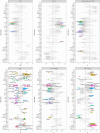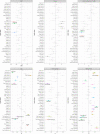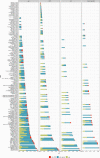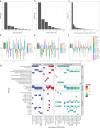Interactions between the lipidome and genetic and environmental factors in autism
- PMID: 37076741
- PMCID: PMC10115648
- DOI: 10.1038/s41591-023-02271-1
Interactions between the lipidome and genetic and environmental factors in autism
Abstract
Autism omics research has historically been reductionist and diagnosis centric, with little attention paid to common co-occurring conditions (for example, sleep and feeding disorders) and the complex interplay between molecular profiles and neurodevelopment, genetics, environmental factors and health. Here we explored the plasma lipidome (783 lipid species) in 765 children (485 diagnosed with autism spectrum disorder (ASD)) within the Australian Autism Biobank. We identified lipids associated with ASD diagnosis (n = 8), sleep disturbances (n = 20) and cognitive function (n = 8) and found that long-chain polyunsaturated fatty acids may causally contribute to sleep disturbances mediated by the FADS gene cluster. We explored the interplay of environmental factors with neurodevelopment and the lipidome, finding that sleep disturbances and unhealthy diet have a convergent lipidome profile (with potential mediation by the microbiome) that is also independently associated with poorer adaptive function. In contrast, ASD lipidome differences were accounted for by dietary differences and sleep disturbances. We identified a large chr19p13.2 copy number variant genetic deletion spanning the LDLR gene and two high-confidence ASD genes (ELAVL3 and SMARCA4) in one child with an ASD diagnosis and widespread low-density lipoprotein-related lipidome derangements. Lipidomics captures the complexity of neurodevelopment, as well as the biological effects of conditions that commonly affect quality of life among autistic people.
© 2023. The Author(s).
Conflict of interest statement
P.M.T. received a research grant from Biogen for research unrelated to this paper. The other authors declare no competing interests.
Figures
















References
Publication types
MeSH terms
Substances
Grants and funding
LinkOut - more resources
Full Text Sources
Medical
Miscellaneous

